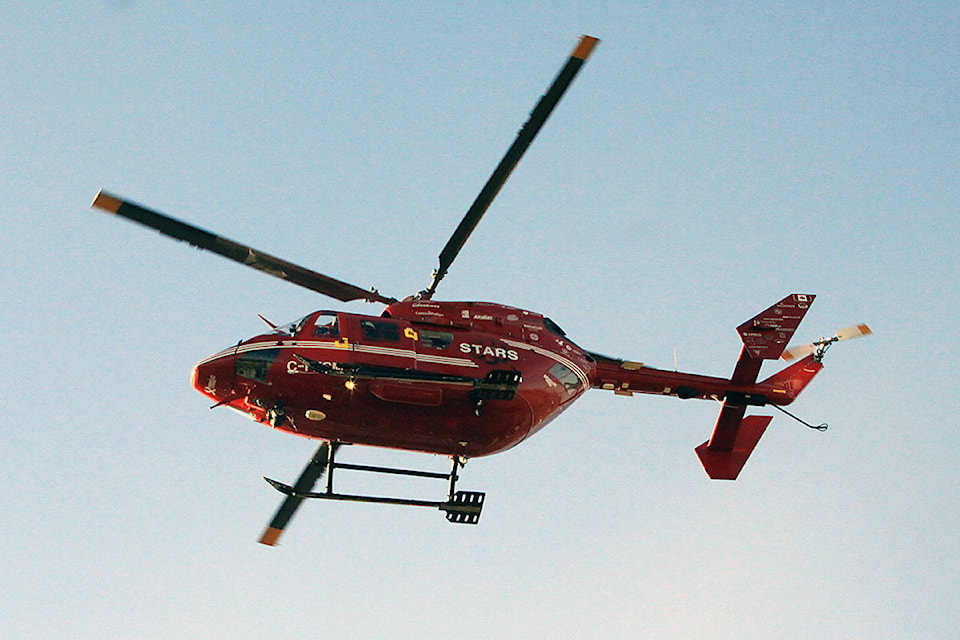Ponoka County council was handed some kudos regarding its leadership in supporting STARS.
Glenda Farnden from STARS (Shock Trauma Air Rescue Service) handed out the compliment in her annual update on the operations during council’s meeting on Feb. 11.
“Thank you on behalf of all our VIPs (very important patients) for your continued partnership support that helps keep STARS in the sky,” she said.
“Thank you for your continued commitment to safety for your residents and neighbours, which have seen positive results with lives saved, and for your standing motion of a $2 per capita contribution. I’ve had significant number of other municipalities come forward, following your leadership on this. With this motion, it ensures the donation is not forgotten or lost, as STARS needs to have this sustainable funding.”
Ponoka County’s contribution is part STARS municipal initiative program that saw $1.8 million raised in 2019 from municipalities across the province as well as northwestern B.C.
“This program is reaching about 90 per cent of Alberta municipalities, who like Ponoka County recognize STARS as being part of their protective services. There is unanimous support in the north and Peace regions, while many towns and villages are joining their surrounding counties in jumping on board with their support,” Farnden said.
“It is really an important factor in supporting STARS sustainability in Alberta.”
In fact, seven municipalities in the province — but only one in the central or southern regions — have donated enough to reach the status of getting their logo onto the helicopters by surpassing the $1 million level in contributions.
As far as missions flown in the area, there were 21 in 2019. That included three scene calls and seven inter-facility transfers from Ponoka. STARS also considers Rimbey — with six calls split between scene and inter-facility — plus Maskwacis (three scene calls) and the village of Westerose (near Pigeon Lake) — two scene calls — to fall within this region.
“That’s right at the 10-year average of calls for the area,” Farnden said, noting the area has seen 214 calls overall in that time.
“However, that is only the missions that have been flown. There are 100s of calls our team fields behind the scenes that no one really sees. From our medical teams determining the best mode of transport to being stood down in-flight to arriving at the scene but not transporting. All of those are a significant part of what STARS does, but are not reflected in our mission numbers.
“It’s also important to understand that the majority of the inter-facility transfers are generated from a scene call, not usually from a patient that is already in the hospital.”
She added that, if some of the neighbouring areas such as Wetaskiwin, Camrose, Lacombe and Clearwater County are included in the 10-year numbers, it translates in to 1,538 STARS missions.
The update also included some great news about the progress of the $117 million helicopter replacement campaign started last year.
STARS has three of their new H145s in the air — at $13 million each — with one in Calgary, one doing pilot training at its bases and one in Saskatoon. The province’s of Alberta and Saskatchewan each paid for one, while the federal government has provided $65 million to pay for five more.
That leaves STARS with $35 million left to purchase the final two they need and to pay for its pilot training program and special equipment costs. The next three are set for delivery in mid-2021 and the other three have been ordered.
“As it stands, we have raised around $10.5 million and have seen a lot of industrial companies and individuals step up with significant support,” Farnden said.
“That includes two northern municipalities each providing $500,000 as they see this as a generational investment.”
On the budget side, STARS continues to fundraise about 80 per cent of its $38.9 million operation in Alberta.
The province did kick in an extra $2 million in 2019, but STARS isn’t certain how much support will be coming in the future considering their agreement with AHS was extended for only this year and no one knows where the AHS review on helicopters will lead.
The STARS lottery, currently underway, remains the single biggest fundraiser with more than $11.5 million taken in last year while the annual calendar is stable at between $800,000 and $1 million.
“It all really does make a difference when people want to support us and the people do want to read those patients stories,” she added.
”So for the last 34 years, we would not be here if not for this kind of support from Albertans.”
